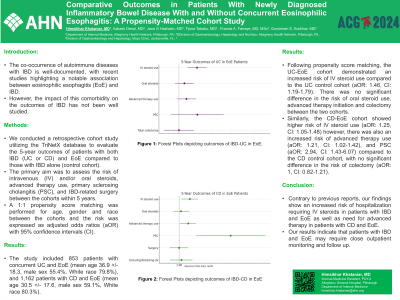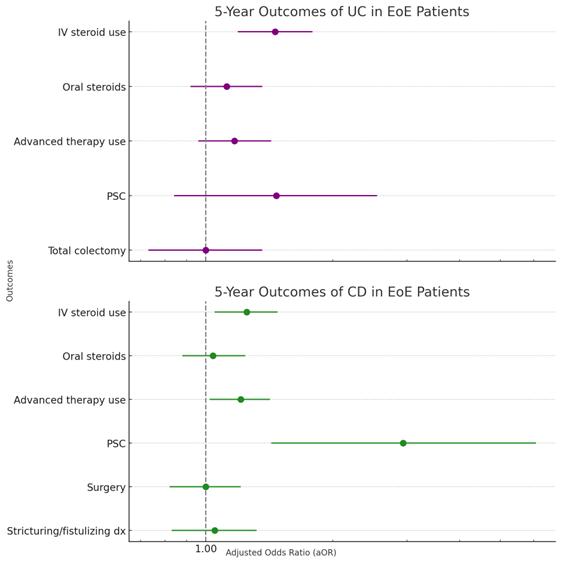Sunday Poster Session
Category: IBD
P0876 - Comparative Outcomes in Patients With Newly Diagnosed Inflammatory Bowel Disease With and Without Concurrent Eosinophilic Esophagitis: A Propensity-Matched Cohort Study
Sunday, October 27, 2024
3:30 PM - 7:00 PM ET
Location: Exhibit Hall E

Has Audio

Himsikhar Khataniar, MD
Allegheny General Hospital
Pittsburgh, PA
Presenting Author(s)
Himsikhar Khataniar, MD1, Aakash Desai, MD2, Jana G. Hashash, MD, MSc3, Fjona Tabaku, MD1, Francis A. Farraye, MD, MSc3, Gursimran S. Kochhar, MD1
1Allegheny General Hospital, Pittsburgh, PA; 2Mayo Clinic, Pittsburgh, PA; 3Mayo Clinic, Jacksonville, FL
Introduction: The co-occurrence of autoimmune diseases with IBD is well-documented, with recent studies highlighting a notable association between eosinophilic esophagitis (EoE) and IBD. However, the impact of this comorbidity on the outcomes of IBD has not been thoroughly investigated.
Methods: We conducted a retrospective cohort study utilizing the TriNetX database to evaluate the 5-year outcomes of patients with both IBD (UC or CD) and EoE compared to those with IBD alone (control cohort). The primary aim was to assess the risk of intravenous (IV) and/or oral steroids, advanced therapy use, primary sclerosing cholangitis (PSC), and IBD-related surgery between the cohorts within 5 years. A 1:1 propensity score matching was performed for age, gender and race between the cohorts and the risk was expressed as adjusted odds ratios (aOR) with 95% confidence intervals (CI).
Results: The study included 853 patients with concurrent UC and EoE (mean age 36.9 +/- 18.3, male sex 55.4%, White race 79.8%), and 1,162 patients with CD and EoE (mean age 30.5 +/- 17.6, male sex 59.1%, White race 80.3%). Following propensity score matching, the UC-EoE cohort demonstrated an increased risk of IV steroid use compared to the UC control cohort (aOR: 1.46, CI: 1.19-1.79). There was no significant difference in the risk of oral steroid use, advanced therapy initiation and colectomy between the two cohorts. Similarly, the CD-EoE cohort showed higher risk of IV steroid use (aOR: 1.25, CI: 1.05-1.48) however, there was also an increased risk of advanced therapy use (aOR: 1.21, CI: 1.02-1.42), and PSC (aOR: 2.94, CI: 1.43-6.07) compared to the CD control cohort, with no significant difference in the risk of colectomy (aOR: 1, CI: 0.82-1.21).
Discussion: Contrary to previous reports, our findings suggest worse outcomes in patients with coexisting EoE and IBD, particularly with an increased risk of hospitalization requiring IV steroids and need for advanced therapy in CD. Our results indicate that patients with IBD and EoE may require close outpatient monitoring and follow up.

Note: The table for this abstract can be viewed in the ePoster Gallery section of the ACG 2024 ePoster Site or in The American Journal of Gastroenterology's abstract supplement issue, both of which will be available starting October 27, 2024.
Disclosures:
Himsikhar Khataniar, MD1, Aakash Desai, MD2, Jana G. Hashash, MD, MSc3, Fjona Tabaku, MD1, Francis A. Farraye, MD, MSc3, Gursimran S. Kochhar, MD1. P0876 - Comparative Outcomes in Patients With Newly Diagnosed Inflammatory Bowel Disease With and Without Concurrent Eosinophilic Esophagitis: A Propensity-Matched Cohort Study, ACG 2024 Annual Scientific Meeting Abstracts. Philadelphia, PA: American College of Gastroenterology.
1Allegheny General Hospital, Pittsburgh, PA; 2Mayo Clinic, Pittsburgh, PA; 3Mayo Clinic, Jacksonville, FL
Introduction: The co-occurrence of autoimmune diseases with IBD is well-documented, with recent studies highlighting a notable association between eosinophilic esophagitis (EoE) and IBD. However, the impact of this comorbidity on the outcomes of IBD has not been thoroughly investigated.
Methods: We conducted a retrospective cohort study utilizing the TriNetX database to evaluate the 5-year outcomes of patients with both IBD (UC or CD) and EoE compared to those with IBD alone (control cohort). The primary aim was to assess the risk of intravenous (IV) and/or oral steroids, advanced therapy use, primary sclerosing cholangitis (PSC), and IBD-related surgery between the cohorts within 5 years. A 1:1 propensity score matching was performed for age, gender and race between the cohorts and the risk was expressed as adjusted odds ratios (aOR) with 95% confidence intervals (CI).
Results: The study included 853 patients with concurrent UC and EoE (mean age 36.9 +/- 18.3, male sex 55.4%, White race 79.8%), and 1,162 patients with CD and EoE (mean age 30.5 +/- 17.6, male sex 59.1%, White race 80.3%). Following propensity score matching, the UC-EoE cohort demonstrated an increased risk of IV steroid use compared to the UC control cohort (aOR: 1.46, CI: 1.19-1.79). There was no significant difference in the risk of oral steroid use, advanced therapy initiation and colectomy between the two cohorts. Similarly, the CD-EoE cohort showed higher risk of IV steroid use (aOR: 1.25, CI: 1.05-1.48) however, there was also an increased risk of advanced therapy use (aOR: 1.21, CI: 1.02-1.42), and PSC (aOR: 2.94, CI: 1.43-6.07) compared to the CD control cohort, with no significant difference in the risk of colectomy (aOR: 1, CI: 0.82-1.21).
Discussion: Contrary to previous reports, our findings suggest worse outcomes in patients with coexisting EoE and IBD, particularly with an increased risk of hospitalization requiring IV steroids and need for advanced therapy in CD. Our results indicate that patients with IBD and EoE may require close outpatient monitoring and follow up.

Figure: Forest Plots depicting outcomes of IBD in EoE
Note: The table for this abstract can be viewed in the ePoster Gallery section of the ACG 2024 ePoster Site or in The American Journal of Gastroenterology's abstract supplement issue, both of which will be available starting October 27, 2024.
Disclosures:
Himsikhar Khataniar indicated no relevant financial relationships.
Aakash Desai indicated no relevant financial relationships.
Jana Hashash: Bristol Myers Squibb – Consultant.
Fjona Tabaku indicated no relevant financial relationships.
Francis Farraye: AbbVie – Consultant. Avalo Therapeutics – Consultant. Bausch – Advisor or Review Panel Member. BMS – Consultant. Braintree Labs – Consultant. DSMB for Lilly. – Sits on. Fresenius Kabi – Consultant. GI Reviewers and IBD Educational Group – independent contractor. GSK, Iterative Health, Janssen, Pfizer, Pharmacosmos, Sandoz Immunology, Sebela and Viatris – Consultant.
Gursimran Kochhar: Boston Scientific Endoscopy – Consultant. DigbI – Stock Options. Eli Lilli – Advisory Committee/Board Member, Speakers Bureau. Olympus Endoscopy – Consultant. Pentax Endoscopy – Consultant. Takeda – Consultant.
Himsikhar Khataniar, MD1, Aakash Desai, MD2, Jana G. Hashash, MD, MSc3, Fjona Tabaku, MD1, Francis A. Farraye, MD, MSc3, Gursimran S. Kochhar, MD1. P0876 - Comparative Outcomes in Patients With Newly Diagnosed Inflammatory Bowel Disease With and Without Concurrent Eosinophilic Esophagitis: A Propensity-Matched Cohort Study, ACG 2024 Annual Scientific Meeting Abstracts. Philadelphia, PA: American College of Gastroenterology.
